|
Life in the
Post-Victorian Era
For many working class families,
life was hard in the early part of the twentieth
century, and expectations were low. People worked long
hours for low wages, and lived in poor and overcrowded
housing. Skilled men could earn up to thirty shillings a
week, and unskilled men could expect to earn no more
than twenty shillings a week. Trades unions were
becoming increasingly militant, and strikes happened
frequently. In 1913 a strike of engineering workers
lasted over two months in an attempt to raise the
minimum wage for unskilled workers to twenty three
shillings a week. There were also strikes on the
railways, and in the coal mines, not forgetting the
great unrest at nearby Wednesbury when the tube makers
downed-tools.
Food was expensive, so much so that
some families spent sixty percent of their income on it,
and malnutrition amongst children became commonplace.
Due to the harder and more stressful living conditions,
and the lack of modern medical care, life expectancy was
much shorter than today, being around fifty years for
men, and fifty four years for women.
The turn of the twentieth century
saw the dawn of the welfare state, but only in a modest
way. In 1909 the first old age pensions were paid to
people over the age of 70. They were entitled to five
shillings a week. Two years later the 1911 National
Insurance Act was passed to provide sickness and
unemployment benefit for people. The scheme was
compulsory for all wage earners between the ages of
sixteen and seventy. They had to contribute four pence a
week to the scheme, which was supplemented by an
additional three pence from the employer, and two pence
from the state. In return, workers received free medical
attention and medicine, and were paid 10 shillings a
week for the first 13 weeks, and 5 shillings a week for
the next 13 weeks. Unemployment benefit consisted of
seven shillings a week, beginning after the first week
of unemployment, and lasting for fifteen weeks in any
single year. It was paid at labour exchanges, which
first appeared in 1910.
For many years Britain had been the
dominant economic power in Europe, but by 1914 Britain
was being outperformed by Germany, which had previously
been an important customer for many of our largest
industries. As Germany’s industries flourished, British
exports suffered, and some industries began to decline.
The Outbreak of War
For some years imperialism had
grown in most of the major European countries, which
meant that at some time, the outbreak war was almost
inevitable. It officially began on 28th July, 1914 with
the assassination of Archduke Franz Ferdinand of
Austria, heir to the throne of Austria-Hungary, and his
wife, Sophie, Duchess of Hohenberg, who were shot dead
in Sarajevo, by Gavrilo Princip, one of a group of six
Bosnian Serb assassins. After the assassination,
Austria-Hungary delivered an ultimatum to the Kingdom of
Serbia and prepared to invade.
At the time there were two groups
of allies in Europe:
|
The Allied Forces - France, United
Kingdom, and Russia.
The Central Powers - Germany and
Austria-Hungary.
|
Britain had a treaty with Belgium,
and so declared war with Germany when the German army
invaded Belgium and Luxembourg, on its way to France.
Soon all the major European powers were involved in the
war, which within a few years involved many countries
throughout the world.
When Britain declared war on 4th
August, 1914 celebrations were held throughout the
country. Most people believed it would be a quick and
simple affair that would be over by Christmas.
Patriotism was high, and large numbers of men rushed to
join the forces to answer the call to arms. The
government wanted 100,000 volunteers and began a large
recruitment campaign which bombarded the public with
posters. This was so successful that within a month
750,000 people had volunteered.
Sadly it was not to be a quick
affair. As the German troops entered France, the French
and British troops moved northwards to meet them, and
the massive armies dug-in, starting the terrible trench
warfare which would last for four years.
The Home Front
The day before the declaration of
war was a Bank Holiday, and crowds gathered on The
Bridge and in Park Street, awaiting an announcement. |
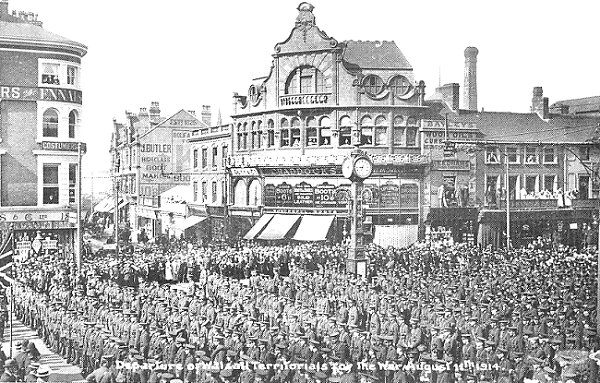 The Walsall volunteers on The Bridge. 11th
August, 1914. From an old postcard.
The Walsall volunteers on The Bridge. 11th
August, 1914. From an old postcard.
|
The Walsall volunteers, members of
the 5th Battalion of the South Staffordshire Regiment
were recalled from their annual camp and mobilised in
Walsall where they were billeted in local schools. On
the 11th August they paraded on The Bridge for a Civic
farewell. After a speech by the mayor, they left for
Whittington Barracks, Lichfield, and the next day
travelled to Luton for training. They landed at Le Havre
on March 1915. The battalion consisted of men from
Walsall, Bloxwich and the surrounding area. Members of
the regiment served at Mons, Ypres, Loos, The Somme,
Saint Quentin Canal, and Gallipoli.
Over 12,000 men from Walsall joined
the armed forces, but sadly over 2,000 of them never
returned. Because so many men had joined-up, there was a
shortage of labour. Industry was essential to the
winning of the war. Factories worked flat-out producing
vital war work and armaments for the armed forces, but
initially suffered because of the shortage of skilled
men. Their roles were taken-over by women, who for the
first time were allowed to work in some of the more
physically demanding factory jobs which had previously
been considered to be only suitable for men. Women also
kept many of the essential services in operation
including the trams, the railways, and our farms. They
also worked in munitions factories.
|

Another view of the gathering on The
Bridge. From an old postcard. Courtesy of Paul Bowman.
|
In August 1914 Parliament Passed
the Defence of the Realm Act which gave the government a
range of new powers to prevent anyone assisting or
communicating with the enemy. The press was censored, to
keep-up people’s morale, and plans were made to ensure
that scarce resources were correctly used. The Admiralty
and the Army Council were given powers to take-over any
factory or workshop for the production of arms,
ammunition, or products for the war-effort. Within
twelve months the shortage of munitions led to the
government setting-up its own arms factories, and
eventually taking over the vitally important coal
industry. All manufacturers turned their skills towards
the war effort including Shannon’s Mill where overcoats
and uniforms were made for the armed forces, and the
Talbot-Stead Company which supplied boiler tubes to the
Admiralty.
The futility of the stand-off
between the vast armies meant that large numbers of
people were killed or wounded, and enormous numbers of
men were needed at the front. In the autumn of 1915 Lord
Derby headed a campaign which resulted in around 300,000
new recruits, but it was still not enough to meet the
needs of the army. In January 1916 the prime minister,
Herbert Asquith introduced conscription for all single
men aged between eighteen and forty, which was seen as
the only way to get all of the troops that were needed.
|
| |
|
|
|
|
| Read about the
Zeppelin raids in January 1916 |
 |
|
Read
about the airship onslaught which rocked Midland
towns |
 |
| |
|
|
|
|
|
The Later War Years
In 1915 the Germans declared an
official naval blockade of Britain, and threatened to
sink any ships sailing into British ports. The Americans
immediately objected because many of their cargo ships
sailed here, and the blockade was cancelled. Two years
later it was reinstated, which caused the Americans to
enter the war.
|

Members of the Red
Cross, at The Bridge, raising funds to buy
more ambulances. From an old postcard. |
In January 1918 Walsall appointed
its first two women police officers, the first in the
Black Country. They were Miss Tearle, and Miss Williams.
After undergoing basic training in London, and gaining
some experience, they started their duties at Walsall in
May 1918. They were paid 35 shillings per week, plus a
wartime bonus of 10 shillings. |
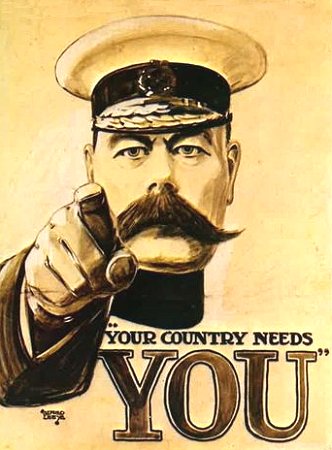
Perhaps the best known and most enduring
image of the First World War is this one of Lord Kitchener. |
|
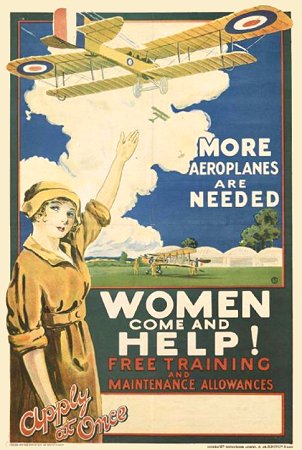
This propaganda poster urges women to help in
building much-needed aircraft. |
|
|

Tank Week in Walsall. From an old
postcard. |
| In March 1918 a British tank which
had been given the name 'Julian' was placed outside the
Town Hall for a week as part of a fund-raising scheme
for the war effort. At the end of Tank Week a total of
£832,207 had been raised. The tank then continued on its
fund-raising tour of the country. |
|
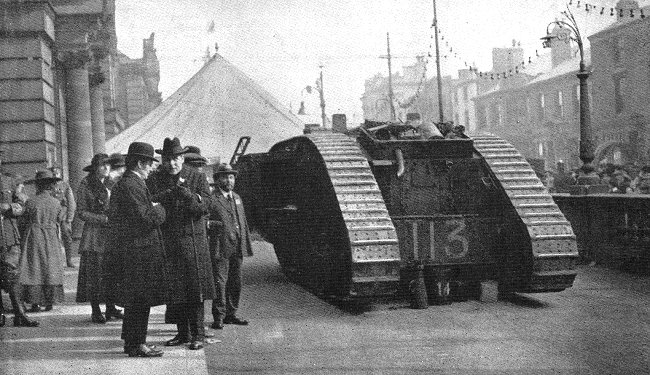
Another view of 'Julian' the tank.
From an old postcard. |
|
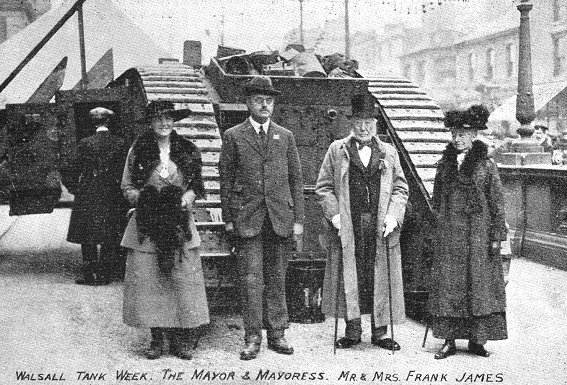
From an old postcard. |
|
The blockade by the German U-boats
led to food shortages, rising prices, and long queues at
the shops. Both sugar and wheat were in short supply.
Due to the shortage of wheat, the Ministry of Supply
recommended that 20lb. of potatoes should be added to
every 280lb. sack of flour. The situation worsened and
led to the introduction of food rationing in February
1918. The weekly ration for each person included 15 oz
of meat, 5 oz of bacon, and 4 oz of butter or margarine.
During the war thousands of Belgian
citizens fled to this country, and Walsall quickly came
to their aid. Hostels were set-up for around 150 people
in Lysways Street, Moss Close, and at Aldridge,
Bloxwich, Pelsall, and Rushall. The refugees were
repatriated after the war.
In 1918 after a German offensive
along the western front, the Allies and the American
forces successfully drove them back, leading to the
armistice on 11th November, 1918, and victory for the
Allies.
The news of the victory quickly
spread throughout Walsall. The Walsall Observer received
a telephone call informing the staff that the war had
ended. They hung a yellow banner from a window on the
first floor, on which was written the word PEACE.
Church bells rang, factory hooters
sounded, flags were flown everywhere, and large crowds
gathered in the town centre. Speeches were made on The
Bridge, buildings were illuminated, bands played in
public parks and everyone celebrated the return to
peace.
The peace agreement was formally
signed on 28th June, 1919. Peace celebrations were held
in the town on 19th July, including a Civic procession,
and tree planting ceremonies at Blakenhall and Bloxwich.
On 24th July the council decided to build the war
memorial in Bradford Place, and cast bronze tablets for
the Town Hall, which listed the names of the dead. A
total £9,208 was raised for the purpose. Other events
included the building of the war memorial in Darlaston,
and the building of the Memorial Park in Willenhall to
honour those who had given their lives in the war.
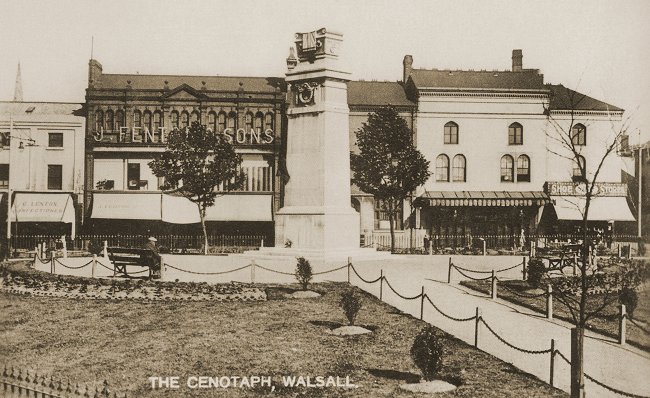
The Cenotaph, Bradford Place. From
an old postcard. |
|
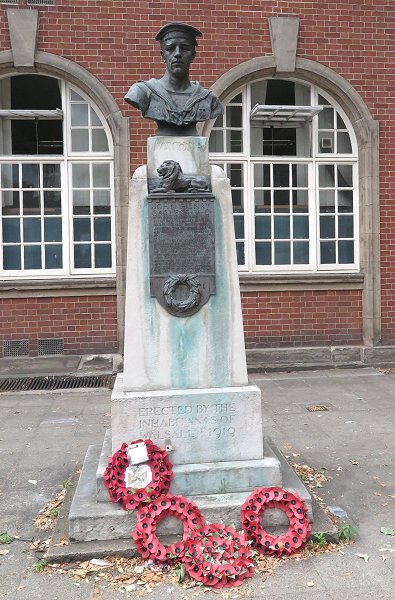
The memorial to John Henry Carless. |
Walsall also erected a memorial to
John Henry Carless who received a Victoria Cross. His
bust stands on a plinth outside the museum in Lichfield
Street. He was born on the 11th November, 1896 in
Caldmore, where he attended St. Mary's Roman
Catholic School. In 1910 he won a gold medal when he
played in the finals of the English Schools Soccer
Shield. He worked as a currier in a local leather
works before joining the armed forces. He initially
volunteered for the army, but was turned down on
medical grounds. He then volunteered for the navy
and was accepted on the 1st September, 1915.
He served as an Ordinary Seaman aboard HMS Caledon, which took part in the Second Battle of Heligoland Bight on
the 17th November, 1917. During the
battle he was working as a rammer on one of guns, and
was wounded in the abdomen. Although severely injured, he
remained at his post, and helped to move other
casualties. After collapsing once, he fell again and
died. He was just twenty one years old.
The bronze bust was produced by R. J. Emerson of
Wolverhampton and stands on a base of Portland
Stone. It was unveiled on the 21st February, 1920 by
Rear Admiral Sir Walter H. Cowan, whose flagship, at
the time of John Henry Carless's death had been HMS
Caledon. |
|
In 1923, Oxford Street, Caldmore was renamed
Carless Street and Regent Street became Caledon
Street.
In December 2009
a memorial plaque commemorating John Carless and two
other recipients of the Victoria Cross was unveiled at
the Town Hall. The other two recipients are James
Thompson, and Charles George Bonner. The war greatly helped the cause of
women’s emancipation and gave them a greater degree of
independence than before.
Although many women lost their
jobs when the hostilities ended, and the men returned,
they now had a more prominent status in society and
increased expectations for the future.
The
Representation of the People Act 1918 gave women over 30
years old the right to vote, but they had to be a
member, or married to a member of the Local Government
Register, or a graduate, voting in a University
constituency.
They had to wait another ten years until
the passing of the Representation of the People (Equal
Franchise) Act 1928 to gain the same voting rights as
men. |
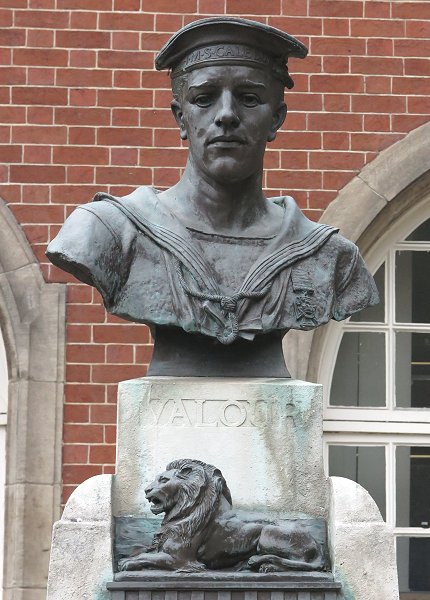
A close-up view of the
memorial to John Henry Carless. |
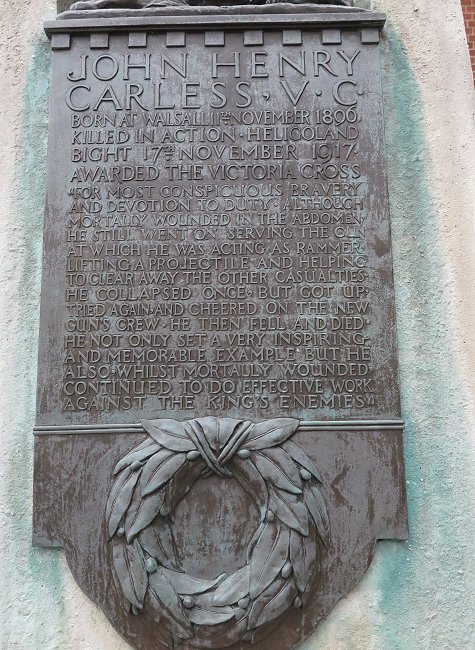 |
| One of the casualties, Bertie
Henry Crick,
Corporal 9362, 7th Battalion, South Staffs
Regiment
The
following information was kindly supplied by
Mark R. Cooper, Bertie's Grandson.
Bertie was born in Wolverhampton on Sunday 13th
April 1890, to John Henry Crick and Bertha Elizabeth
Crick. His father, a baker,
moved to Wolverhampton from
Northampton and Bertie became a moulder in a local
foundry. He lived at
111 Green Lane, Walsall and
married
Edith Sarah Kettledon, a laundress from Wednesbury.
They were married on Friday 26th December, 1913 at
St. Michael’s Church, Caldmore and moved to 66
Orlando Street, Walsall.
At the
outbreak of war,
Bertie enlisted in the
South Staffs Regiment
and was drafted to
Gallipoli on Saturday 11th September, 1915. In
December of that year, when the British troops were
withdrawn from Gallipoli, he served in Egypt.
He returned to France
on
Saturday 24th February, 1917 and
was promoted to
Corporal.
His battalion moved into Belgium and took part in
the terrible trench warfare that characterised the
war. On Sunday 15th July, his battalion moved from Camp
'O' near Poperinghe to the trenches about a mile
north of Ypres, to relieve the 4th and 5th
battalions.

Marching to war. From an old
postcard.
The
trenches were in full view of the
German artillery on nearby
Passchendaele Ridge. The German troops bombarded
them with
shells and rifle fire, which resulted in many
casualties. On 17th July, during his second day in
the trenches, Bertie was seriously wounded, either by an
exploding shell or rifle fire and died. He was just
27 years old.
The
battle continued until 31st July when the allies
captured the German held
Passchendaele Ridge. During the battle over 300,000
British and allied soldiers were killed or
wounded in one of the most horrific battles of the
First World War.
Bertie is buried in La Brique Military
Cemetery No.2 with his colleagues, in grave 1.W.5.
He is commemorated on the Roll of Honour at the Menin Gate
Memorial in Ypres, and in Walsall Town Hall, and
also in St. Matthew’s Church.
His widow Edith, later married Sergeant Joseph Booth Gretton in 1919
and they lived at Clay
Street, Penkridge. He also fought at Ypres,
where he was gassed and discharged, being unfit
for service. |
 |
|
 |
|
 |
Return to
Public Houses |
|
Return to
the beginning |
|
Proceed
to
The 1920s |
|